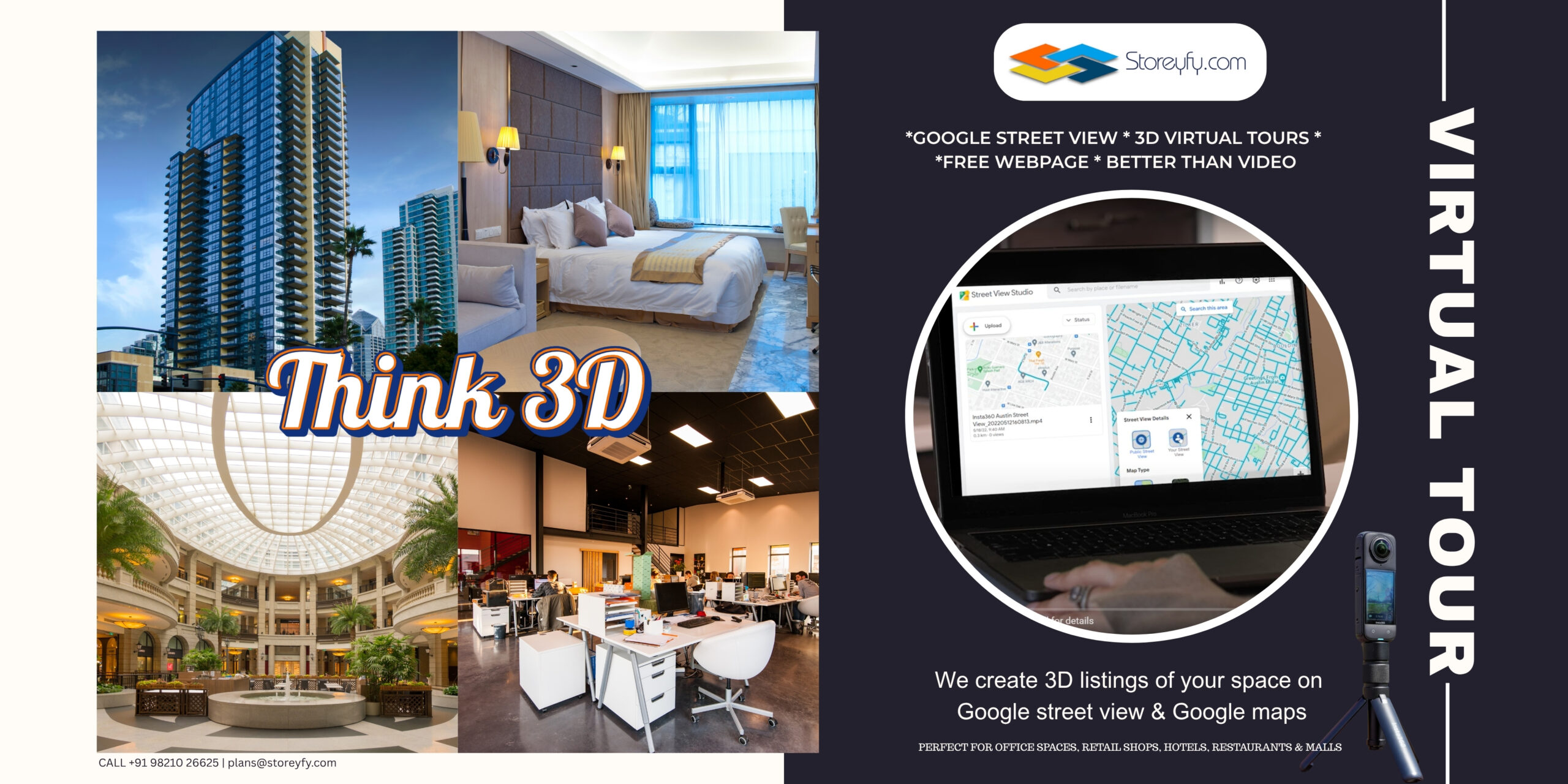In today’s rapidly evolving digital landscape, the way we experience and interact with spaces has undergone a profound transformation. From real estate and architecture to retail and hospitality, businesses are constantly seeking innovative methods to engage their audiences and showcase their offerings. While traditional videos have long served as a visual medium, a more immersive and interactive alternative has emerged: the virtual tour. This blog post will delve into the distinct advantages of a virtual tour compared to a standard video, highlighting its superior interactivity, immersive qualities, and adaptability.
Interactivity: Stepping Beyond Passive Viewing
One of the most significant differentiators between a virtual tour and a video lies in the level of user engagement. A video, in its essence, is a linear presentation. Viewers are passive recipients of information, limited to watching what the camera operator dictates. They have no control over the pace, perspective, or the details they choose to explore. This passive experience can often lead to disengagement, especially if the viewer’s specific interests aren’t adequately addressed by the video’s narrative.
A virtual tour, conversely, empowers the user. It’s an interactive experience where the viewer takes the reins. They can navigate the space at their own pace, choosing the directions and areas that pique their curiosity. This active participation transforms the viewing experience from a simple observation into an exploration.
Consider a real estate application. In a video, a potential buyer is guided through the property by the presenter, and specific features are highlighted at the presenter’s discretion. While this approach can be helpful, it might overlook aspects that are particularly important to the buyer. For example, the buyer might be most interested in the natural light in the living room or the functionality of the kitchen layout.
In a virtual tour, the buyer can freely roam the property, examining every corner and detail. They can virtually “walk” through each room, zoom in on specific features, and even measure dimensions. Interactive elements, such as clickable hotspots, can provide additional information about furniture, appliances, or architectural details. This level of control and accessibility fosters a deeper connection between the viewer and the space, increasing the likelihood of genuine interest and engagement.
The interactivity offered by virtual tours also extends to providing supplementary information. Instead of relying solely on visuals, virtual tours can incorporate text descriptions, audio narration, embedded videos, and even links to external resources. This multimedia integration allows users to delve deeper into specific aspects of the space, learning about its history, design, or features.
The ability to interact with a virtual tour from any device—computer, tablet, or smartphone—further enhances its accessibility. Potential customers can explore a property or space from the comfort of their own homes, at any time and place. This removes geographical barriers and eliminates the need for physical visits, saving time and resources for both businesses and clients.
Immersive Experience: Transporting Viewers into the Heart of the Space
Beyond interactivity, virtual tours offer a significantly more immersive experience than traditional videos. The technology behind virtual tours allows for a sense of presence, making viewers feel as though they are physically present in the space. This level of immersion stems from several key features:
- 360-Degree Views: Virtual tours are typically created using 360-degree photography or video. This means that the viewer can look up, down, and all around the space, gaining a complete understanding of its layout and ambiance. This panoramic perspective offers a far more realistic and comprehensive representation than a video, which is restricted by the camera’s limited field of view.
- Realistic Visuals: High-quality virtual tours utilize advanced imaging techniques to capture incredibly detailed and lifelike representations of spaces. The use of professional-grade cameras, lighting, and post-processing ensures that the visuals are crisp, clear, and visually appealing. This level of realism contributes significantly to the overall immersive experience, making it easier for viewers to imagine themselves within the space.
- Walk-Through Navigation: Virtual tours enable users to “walk” through a space as if they were physically present. They can move from room to room, explore different areas, and get a sense of the flow and layout of the property. This intuitive navigation further enhances the feeling of presence and allows viewers to better understand the spatial relationships within the environment.
- Ambience and Sound: Many virtual tours incorporate ambient sounds, such as background music or the sounds of a bustling city street, to enhance the sense of immersion. The addition of these audio elements can further transport the viewer into the space, creating a more engaging and memorable experience.
The immersive nature of virtual tours can be particularly beneficial in various industries:
- Real Estate: Prospective homebuyers can experience a property as if they were physically there, allowing them to get a feel for the space, even if they are located across the country.
- Hospitality: Hotels and resorts can showcase their rooms, amenities, and surroundings in a visually compelling way, enticing potential guests to book a stay.
- Retail: Retail stores can provide virtual shopping experiences, allowing customers to browse their products and visualize them in their own homes.
- Architecture and Design: Architects and designers can use virtual tours to present their projects to clients, allowing them to experience the design and make informed decisions.
The immersive quality of a virtual tour goes beyond merely showing the space; it creates an emotional connection. It evokes a feeling of being present, which can lead to a stronger engagement with the space and a greater likelihood of positive outcomes.
Flexibility and Customization: Tailoring the Experience to Your Needs
Virtual tours offer a level of flexibility and customization that is simply unattainable with a traditional video. They can be adapted and tailored to meet the specific needs of different audiences and applications. This adaptability provides a significant advantage over static video content, which is often a one-size-fits-all solution.
Here are some examples of the customization options available with virtual tours:
- Branding and Design: Virtual tours can be branded with a company’s logo, color scheme, and other visual elements to align with their brand identity. This branding helps to reinforce brand recognition and create a cohesive user experience.
- Interactive Elements: As mentioned earlier, virtual tours can incorporate interactive elements like hotspots, pop-up windows, videos, and audio narration. These elements provide additional information and engagement opportunities, allowing users to learn more about the space and its features.
- Navigation Options: Virtual tours can offer different navigation options, such as point-and-click navigation, guided tours, and floor plans. This flexibility allows users to navigate the space in a way that best suits their preferences and needs.
- Accessibility Features: Virtual tours can be designed with accessibility features, such as text descriptions, closed captions, and audio descriptions, to make them accessible to users with disabilities.
- Integration with Other Platforms: Virtual tours can be easily integrated with other platforms, such as websites, social media, and online marketplaces. This integration allows businesses to seamlessly incorporate virtual tours into their existing marketing and sales efforts.
- Analytics and Tracking: Virtual tour platforms often provide analytics and tracking features, which allow businesses to monitor user engagement and track the performance of their virtual tours. This data can be used to optimize the virtual tour experience and improve overall marketing efforts.
- Virtual Staging: For real estate applications, virtual tours can be used to virtually stage properties. This involves adding virtual furniture, decor, and accessories to empty spaces, allowing potential buyers to visualize the property’s potential.
- Updates and Revisions: Unlike a video, which requires a complete re-filming for any updates, virtual tours are easily editable. Information, virtual staging, or interactive elements can be readily modified.
The flexibility and customizability of virtual tours make them a versatile solution for a wide range of applications. Businesses can tailor the experience to meet the specific needs of their target audience, creating a more engaging and effective presentation. This adaptability enables companies to create compelling virtual experiences that drive interest, generate leads, and ultimately, boost sales.
Conclusion: Embracing the Power of Virtual Tours
In summary, virtual tours offer a distinct advantage over traditional videos due to their superior interactivity, immersive qualities, and adaptability. They empower users to explore spaces at their own pace, providing a more engaging and personalized experience. They create a sense of presence, allowing viewers to connect with a space on a deeper level. And they can be tailored to meet the specific needs of different businesses and audiences.
As technology continues to evolve, virtual tours are poised to become an increasingly essential tool for businesses across various industries. By embracing the power of virtual tours, businesses can create immersive and interactive experiences that drive engagement, generate leads, and ultimately, achieve their marketing and sales goals. The shift from passive video to interactive virtual tours represents a significant step forward in how we experience and interact with the world around us, opening up new possibilities for communication, engagement, and success.


